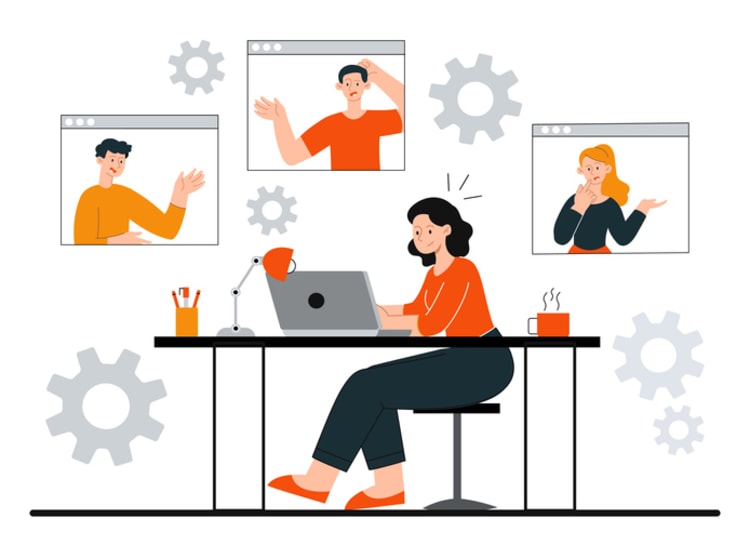Imagine a world where you can collaborate with your team in a fully immersive virtual environment, brainstorming ideas on a 3D whiteboard while feeling as if you’re all in the same room. Welcome to the exhilarating world of VR meetings! As remote work continues to rise and technology advances, VR meetings are unlocking the future of collaborative work, providing immersive and interactive experiences that revolutionize communication and teamwork in the realm of VR meetings.
Key takeaways
- Experience the future of remote work with Virtual Reality Meetings!
- Exciting technological advancements in VR hardware and software enable businesses to host immersive virtual conferences.
- Companies are seeing impressive cost savings, increased productivity, and improved collaboration with VR meetings!
The emergence of VR meetings

As remote work gains popularity, the need for more engaging and effective communication tools has never been more apparent. This demand has accelerated the advent of VR meetings, which present immersive virtual meeting room experiences for collaboration, surpassing the limits of traditional video conferencing tools like remote meetings. Virtual meetings are now becoming the new norm for many organizations, especially for virtual business meetings.
Advancements in VR technology, like Meta Quest and other VR headsets, have enabled the creation of virtual reality offices and conference rooms, converging meeting participants in a manner reminiscent of in-person meetings.
Remote work revolution
The shift towards remote work has been fueled by factors such as talent acquisition and retention, work-life balance, and cost savings. This revolution has significantly influenced business communication, promoting the use of virtual meeting rooms and redefining how businesses work together.
Yet, remote work carries its own set of challenges. The isolation of working alone can be offset by a VR conference, which can bring teams together more immersively and engagingly.
Technological advancements
The advent of VR meetings relies heavily on the remarkable progress in VR hardware and software. Combining augmented reality (AR) and virtual reality (VR) technologies has allowed us to create realistic and interactive virtual environments, making VR business meetings more effective and engaging than traditional video conferencing.
Companies at the forefront of VR technology progress include:
These companies are making it possible for businesses to host virtual conferences using VR avatars for more engrossing communication and team effort.
Essential components for a VR meeting

Hosting a successful VR meeting demands participants to have the appropriate tools at hand– VR headsets and controllers, a virtual meeting platform, and a high-speed internet connection. These components work together to create an immersive and interactive experience, allowing users to communicate and collaborate effectively in virtual environments.
VR headsets and controllers
Devices like the Meta Quest 2 provide the necessary hardware for immersive VR experiences in meetings. With its Direct Touch feature, users can interact with the VR environment using their bare hands, while mixed reality support creates immersive and collaborative experiences.
The selection of an appropriate VR headset and controller plays a pivotal role in guaranteeing seamless interaction and engagement during VR meetings.
Virtual meeting platforms
Platforms such as Kumospace, Spatial, and MeetinVR offer customizable virtual environments and collaboration tools for VR meetings. They provide essential features like virtual whiteboards, shared screens, and interactive elements that enable better collaboration and innovation.
While selecting a virtual meeting platform, businesses should weigh the platform’s features, capabilities, and alignment with their specific needs and prerequisites.
High-speed internet connection
A stable and speedy internet connection is of utmost importance for seamless VR meeting experiences. For smooth VR meetings, an internet speed of at least 20 Mbps download and 3 Mbps upload is recommended.
Maintaining a high-speed and stable internet connection allows participants to reduce delays, disruptions, and other technical issues that could impede the effectiveness of the meeting.
Enhancing collaboration with VR meetings

VR meetings offer immersive environments, interactive tools, and customization options that improve collaboration and engagement among participants. Offering realistic 3D spaces, virtual whiteboards, and file-sharing capabilities, VR meetings foster superior collaboration and innovation, leading to more productive and efficient team meetings.
Immersive environments
VR meetings, also known as virtual reality meetings, provide realistic 3D spaces that help participants feel more connected and focused during meetings. These immersive environments, filled with various 3D objects, increase the sense of presence and engagement, allowing users to truly feel physically present in a shared virtual space.
Immersive environments, by effectively blocking real-world distractions, aid people in concentrating intensely on the matters at hand, leading to more productive and successful meetings.
Interactive tools
Virtual whiteboards, file sharing, and 3D modeling tools enable better collaboration and innovation in VR meetings. These interactive tools allow users to share documents, presentations, and videos, as well as visualize ideas and concepts through collaborative features.
Offering a variety of interactive tools, VR meetings can promote superior communication and cooperation among team members, leading to more effective problem-solving and decision-making processes.
Customization and personalization
Users can tailor virtual environments and avatars to their preferences, making VR meetings more engaging and enjoyable. Customization options, such as user profiles, preferences, and settings, allow users to create a unique and unforgettable experience.
Personalization helps hold attendees’ interest and attention, resulting in heightened engagement and participation in the meeting.
Overcoming challenges in VR meetings

Addressing technical issues, user adoption, and accessibility concerns is pivotal for the successful implementation of VR meetings. Ensuring reliable hardware, software, and internet connections, encouraging employees to familiarize themselves with VR technology, and providing alternative options for those without VR hardware can help overcome these challenges and ensure all participants can join and benefit from VR meetings.
Technical issues
Ensuring reliable hardware, software, and internet connections is important to minimize technical problems during VR meetings. Here are some steps you can take to ensure a smooth and seamless VR meeting experience:
- Confirm time zones to avoid scheduling conflicts.
- Test equipment and connections before the meeting to ensure everything is working properly.
- Provide technical support to participants in case they encounter any issues.
- Use reliable and stable internet connections to prevent lag or disconnections.
By following these steps, you can mitigate or resolve technical issues and ensure a successful VR meeting.
User adoption
Motivating employees to become acquainted with VR technology and providing training can enhance user adoption rates. Addressing common obstacles to user adoption, such as technological adaptability, video quality, and organizational culture, is crucial for ensuring successful implementation and maximizing the potential of VR meetings.
Accessibility and inclusivity
Developing inclusive VR meeting platforms and providing alternative options for those without VR hardware can help ensure all participants can join. Addressing the needs of differently-abled participants, including physical accessibility barriers and the need for accommodations, is important for creating a more inclusive and accessible VR meeting experience.
Real-world examples of VR meeting success

Companies like Nestle Purina and Program-Ace have successfully implemented VR meetings, resulting in cost savings, increased productivity, and improved collaboration. Nestle Purina saw impressive cost savings as a result of training salespeople through virtual tours of its production facilities. It saved $100K a year in travel and lost productivity costs. Program-Ace’s MetaOffice showcases VR technology’s potential to revolutionize how businesses interact and collaborate in today’s digital landscape.
These companies, by adopting VR meetings, have showcased how virtual reality can revolutionize the way businesses communicate and collaborate. As more companies follow suit, the benefits of VR meetings will become increasingly apparent, leading to even greater adoption and innovation in the field.
The future of VR meetings and workspaces

With the continual evolution of VR technology, its integration with other technologies and reshaping traditional office spaces is likely, to pave the way for a more immersive and collaborative work environment. Combining VR with augmented reality (AR) and other communication tools can create even more engaging and effective meeting experiences, while the future of workspaces may involve a blend of virtual and physical environments.
Integration with other technologies
Integrating VR with augmented reality (AR) and other communication tools can lead to even more engaging and effective meeting experiences. By combining these technologies, businesses can provide a seamless and immersive experience that enhances collaboration and productivity.
As VR continues to evolve and become more accessible, even greater innovation and integration with other technologies can be anticipated in the future.
Evolving office spaces
The future of workspaces might incorporate a blend of virtual and physical environments, with VR meetings having a significant role in remote collaboration. As businesses embrace the benefits of VR technology, traditional office spaces will likely evolve to accommodate this new way of working.
Through the integration of virtual environments and physical environments, businesses can construct engaging and collaborative workspaces that promote innovation and productivity.
Summary
VR meetings are unlocking the future of collaborative work, offering immersive and interactive experiences that go beyond traditional video conferencing. As remote work continues to rise and technology advances, businesses can benefit from embracing VR meetings to improve communication, collaboration, and productivity. With the integration of other technologies and the evolution of workspaces, VR meetings will likely play a significant role in shaping the future of work.
Frequently asked questions
Virtual reality meetings are becoming increasingly popular, providing the benefit of feeling closer to colleagues and reading nonverbal cues. Get excited about this emerging technology - you can now have amazing VR meetings!
VR meetings provide increased collaboration and productivity - enabling participants to interact with each other in an immersive, realistic way and quickly resolve issues. This can dramatically boost team performance and efficiency!
VR collaboration is a type of technology that enables remote users to communicate and collaborate in a shared virtual space. Users can present and evaluate 3D models, with instantaneous changes being made in real-time. This allows for a more visually engaging and activity-oriented experience than traditional meetings.
Experience the convenience of virtual meetings with popular VR platforms like Kumospace, SpatialChat, and MeetinVR!
Experience the cutting-edge technology of virtual reality meetings with VR headsets and controllers, like Meta Quest 2!





